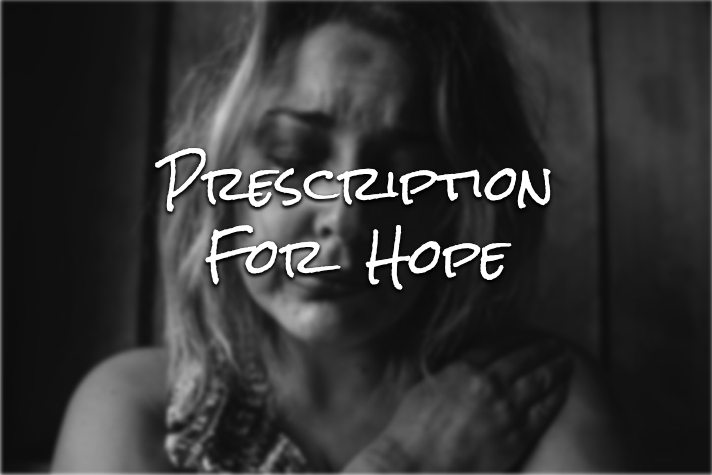
This is the seventh in an occasional series offering a Biblical perspective on the opioid crisis that reportedly claims 130 lives daily nationwide. The first six pieces examined the church’s response, praying parents and community members determined to see their piece of the world change. Today’s feature takes a look at a smaller segment of our nation crippled by the well-meaning crackdown on narcotics prescriptions. People like Ann*, interviewed below, just want to function. Yet their need for ongoing narcotics prescriptions puts them in a precarious position as doctors toe the line between clinical and political realities. Here’s Ann’s story:
“You have said, ‘Seek my face.’ My heart says to you, ‘Your face, Lord, do I seek.’”
—Psalm 27:8
Ann* is one of 50 million Americans who battles chronic pain with limited relief. But for all the struggle she’s been through—particularly up against new guidelines that make it challenging for doctors to prescribe narcotics—she wouldn’t change one day.
This downright impossible journey has brought her closer to Jesus.
“It’s been the biggest blessing,” Ann shared earlier this spring while sitting in a café in Western North Carolina. Her voice cracked with emotion.
“And I will tell you, I will sit here after I’ve told you all I’ve been through, I would not change that. I would not. It’s meant that much to me.”
Ann can trace her pain journey back to tension headaches she suffered in high school, on into college and her dream career as a special education instructor. She initially willed herself through the agonizing pain. A doctor told her she suffered from migraines. Some of her symptoms fit, so she believed him. Why wouldn’t she?
But her pain continued to build. Nothing worked. None of the 30-some prescriptions, Botox injections, infusions, nerve blocks, acupuncture, chiropractic care—you get the picture. The pain was eroding her life when seemingly out of the blue, a pain specialist prescribed 5mg of hydrocodone, a narcotic painkiller. The clouds lifted. She could function.
God’s Word & Medicine:
Ezekiel 47:12 and Revelation 22:2 are two Bible verses that Addiction Counselor Tal Prince shares with patients to suggest that God does permit the appropriate use of legalized medicine. Prince, stepson of Cliff Barrows, runs his own practice in Alabama.
“I would get a reduction in pain, and I would get function for about four hours,” Ann said.
But as it often goes for the treatment of chronic conditions, just like diabetes, thyroid and so on, the medicine prescribed yesterday might not do the trick today. Ann tried talking with the pain specialist.
“I told him, ‘I’m just not getting relief. Can you increase the dose?’ He said, ‘No. And in fact, we don’t do that at this practice.’” Ann remembered, her pleasant expression shifting to disbelief as she relived the shocking moment all over again. “He kind of patted me on my head and sent me on my merry way. A pain specialist dropped me because I had pain.
“I felt abandoned. I just felt like I had this one thread that I was hanging on that was slightly effective in improving my life the slightest bit and he just snatched it all away.”
Narcotics Defined:
The Drug Enforcement Administration says the word narcotic “comes from the Greek word for ‘stupor’ and originally referred to a variety of substances that dulled the senses and relieved pain.” Today, narcotics encompass prescription medicines such as painkillers like OxyContin and illegal drugs like carfentanil and heroin. Whether prescribed or illegally dealt, nearly all narcotic painkillers are Schedule II drugs, which means they are a risk for abuse, creating psychological or physical dependence.
Ann was devastated, but she kept praying, drawing closer to the Lord. She began researching when the pain would allow. By this point, she had stepped down from her dream job. The pain was compromising her health. Chinese medicine helped her regain some of her physical well-being but did nothing for the pain.
So it was back to experimental care—more medications, more infusions, more time wasted. More bad days spent in bed than good days when she could maybe do a load of laundry.
A Diagnosis Hard to Pin Down
Ann was frustrated, ashamed even. Anytime she brought up narcotics as an option, the medical professional shut her down. Head pain was tricky, they said. Narcotics wouldn’t work, they said. She had prior experience that told her otherwise.
In some cases, the doctors believed their hands were tied—nothing showed up on any scans so there wasn’t physical proof other than Ann’s visible pain or her seven years’ worth of headache data detailed down to the day’s barometric pressure. Unfortunately, chronic pain is a subjective experience that has yet to be clinically proven.
Dr. Clas Linnman, assistant professor at Harvard’s Medical School, has spent some of his career trying to quantify chronic pain. It’s one thing, he says, to pinpoint a painful experience. A part of the brain will flash under imaging. But mapping ongoing pain is a much more challenging task that requires a considerable investment of time and funding.
“It seems like a simple thing to ask: Is there real pain or not? But it’s more complicated than that,” said Linnman, who also works at Spaulding Rehabilitation Hospital in Massachusetts. “Think of it as an emotion. Are you scared or not? You should probably believe the person who says he or she is scared, but it’s very hard to get an objective measure of that.”
This can translate into a polarizing experience for chronic pain patients in the physician’s office. Ann always felt supported by her husband but rarely by her doctors. The skepticism she received from the doctors, combined with required—sometimes pricey—urinalysis, made her feel almost criminal.
Searching for Pain Relief While Fighting an Epidemic
Patients in chronic pain are desperate to be believed. The lack of trust sometimes triggers depression. Meanwhile, doctors are under considerable pressure to do their part to reverse the opioid epidemic catalyzed by massive overprescription in years past. For perspective, in 2012, the Centers for Disease Control and Prevention (CDC) stated “health care providers wrote 259 million prescriptions for opioid pain medication, enough for every adult in the United States to have a bottle of pills.”
Since then, really since the opioid crisis was declared a national emergency in 2017, governmental entities have been putting teeth into the CDC’s opioid-prescribing guidelines in an effort to save lives. States like North Carolina have passed the Strengthen Opioid Misuse Prevention Act that aims to “prevent inappropriate prescribing.” All 50 states have prescription monitoring programs. In 2018, the Department of Justice rejoiced to report the rate of prescription narcotics was at an 18-year low.
But within those statistics are chronic pain patients who all of a sudden had to figure out life without the narcotics that helped them function. People like Ann who never expect to live life pain-free; they just want to be able to go to the grocery store or RSVP “yes” instead of “maybe” to a social event.
“There’s the other end of the spectrum where [narcotics] are very appropriate medications in the right context,” said Dr. Lance Plyler, director of World Medical Mission for Samaritan’s Purse. “There’s some that are no-brainers, people who have stage 4 cancers that are in horrific pain. There’s no question that’s a very appropriate use of narcotics. There are other patients, too, where you’ve explored all other options and really we’ve leveraged every option we can think of and still they’re in tremendous pain.”
Plyler, who also fields hospital shifts at Watauga Medical Center in Western North Carolina, can remember a time when physicians were accused of underusing narcotics. With an average of 130 Americans dying daily from opioid-related overdoses, Plyler firmly agrees the prescription pendulum should be swinging the other way. It’s responsible. But it’s also responsible, he said, to care for chronic pain patients when traditional and non-traditional methods aren’t providing relief.
Alternatives for Dealing with Chronic Pain:
Every patient is different so there isn’t one medical diagnosis or solution that fits them all. Here is a short, but by no means exhaustive, list of non-drug therapies Dr. Lance Plyler shared that may help someone in chronic pain. Plyler is director of World Medical Mission for Samaritan’s Purse.
- Chiropractic care.
- Behavior modification such as memorizing Scripture.
- Explore the likelihood of depression. Billy Graham, in one of his My Answer columns, offered a Biblical response to medically treating depression.
- Explore non-steroidal, anti-inflammatory drugs designed to relieve pain by eliminating inflammation.
- Reset your diet by following one geared toward anti-inflammation.
- Talk with your doctor about a nerve block.
“While this epidemic is going on, on the flip side, there is a very legitimate and appropriate use of narcotics, even for the Christian patient that has chronic pain,” he said. “I think we have to be very careful who that is, but there’s clearly appropriate use for chronic pain situations.”
The definition of appropriate can be subjective, too, across prescribing physicians. For that reason, Dr. Eleanor Greene, a past president with the North Carolina Medical Board, encouraged doctors in a newsletter to be guided by their clinical judgment and not a disciplinary response. She gave an example: the board reviewed and dismissed three cases where physicians were allegedly overprescribing narcotics. There was no disciplinary action.
Scripture in the Prescription
Pain is an unfortunate reality for patients like Ann even when they’re taking prescribed narcotics. Dr. Plyler has encouraged patients to try nontraditional therapies including behavior modification. It might sound lame, he said, but adjusting your response to pain can offer some relief.
“For the Christian, it can be something as simple as having a Scripture that they really go to because some people, they have to live with pain,” Plyler said.
There have been times Plyler said he has pulled out his prescription pad and written down the Bible verse Philippians 4:6-7. Sometimes it’s just the reference and other times it’s the entire verse. Put this on your refrigerator, he’ll tell his patient.
“Do not be anxious about anything, but in everything by prayer and supplication with thanksgiving let your requests be made known to God. And the peace of God, which surpasses all understanding, will guard your hearts and your minds in Christ Jesus.” —Philippians 4:6-7
“I encourage them that God is aware of your pain, and you have to just put it before the Lord,” he said. “It’s easy to get anxious and worry about this, but just leave it before God, and God’s going to carry you. Maybe He won’t take away your pain completely, but He can give you a peace that transcends all understanding even in the midst of your pain. He can give you a peace and give you a way to deal with it.”
Neuroscience Study on Prayer:
One 2017 neuroscience study suggests that praying can make a difference in the incidence of pain. More research is needed, but the study indicated: “As a religious coping strategy, prayer may in some circumstances allow devout participants to cope with pain by dissociating from part of the negative input of the stimulus.”
Misdiagnosis
Prayer is a key part of life for Ann, who accepted Jesus Christ as her Lord and Savior while watching a Billy Graham TV special in 1983. Nothing, she said, has refined her faith like the trial of chronic pain. She can’t attend church on a regular basis, but she continually seeks His face.
That hope, combined with the support of her husband and prayer partners, has kept her from reaching a tragic breaking point. A 2018 study by a team of CDC researchers established chronic pain as a risk factor for suicide.
That’s not Ann’s story. She’s felt supported everywhere except in the physician’s office. So when she visited a new pain management physician in February 2018, she braced for the worst—a continuation of unrelieved pain.
“I felt like this was my Hail Mary,” she said. “I felt like this was it.”
The physician, with his arms folded across his chest, barely entered Ann’s room. He predictably dismissed her request, and Ann’s husband spoke up. Wasn’t there anything they could do?
Get another doctor to lend his support, Dr. Arms Crossed said before suggesting maybe Ann had been misdiagnosed. Turns out, she was. She has neuralgia, defined as intense pain along a nerve, particularly in the head or face. It had been masquerading as chronic migraines all along.
The new diagnosis fit better, and with a second doctor’s support, Ann began using a transdermal patch that slowly released 25mcg of fentanyl, a synthetic prescription narcotic.
Wait. Isn’t Fentanyl Illegal?
Fentanyl, often in the headlines for overdose deaths, is almost 100 times more powerful than morphine and typically used to treat cancer pain. Like so many other opioids, it becomes a problem when it falls into the wrong hands. Drug dealers become kitchen chemists who use it to boost heroin. It increases profits, but can tragically kill the buyer.
“It changed my life,” she said. “In three months I had the best three months I’ve had in years. After three days of the patch, the medication started working and it was like a flip of a switch. Yeah, my head still hurts and all the things that aggravated it before aggravate it still—activity, heat, cold, wind, the same, but I could live and the first thing I realized was I was so exhausted. I had no momentum.”
Over time, the patch began to impact her skin. Dr. Arms Crossed told her she was at tolerance. But instead of dropping her like her first pain specialist, he told her she needed to take a four-week break, the equivalent of a detox, and come back. She did. This time a 12.5mcg patch did the trick. It still is, thankfully.
‘That’s Where My Faith Comes In’
On this particular day, Ann categorizes her life as functioning. She vacuumed and did a bit of laundry before heading to the café.
She insists God has used this struggle to get her attention. Not only that, but she’s convinced—along with her prayer partners—that her healing will come this side of heaven. In His time. For now, she just trusts Him and is grateful for the medication that enables her to have functioning days.
“That’s where my faith comes in, and I have to wait and be still,” Ann says, smiling. “And hear that voice that comforts me or reassures me. That’s the one thing this journey has shown me, is that I can hear the voice of God. And I know what that voice is. The sheep hear His voice and they know His voice. That resonates with me.”
Find Peace in the Midst of Your Trial.
*Name changed to protect privacy.
This article is the seventh in an ongoing series about the opioid crisis. Read the first six installments:
Part 1: The Opioid Epidemic Is ‘Every Single Christian’s Problem’
Part 2: ‘She Belongs to Jesus’: Fighting for Loved Ones Overcome by Opioid Addiction’
Part 3: Newborns, Mothers Navigate Opioid Crisis
Part 4: Jesus Is Only the Beginning as Churches Unite to Find Hope Over Heroin
Part 5: Dayton Steadies in the Opioid Fight: ‘God Is Raising Up Things All Over This City’
Part 6: ‘As Long As There’s Breath In a Body, There’s Always Hope’: Opioid Epidemic Behind Bars

